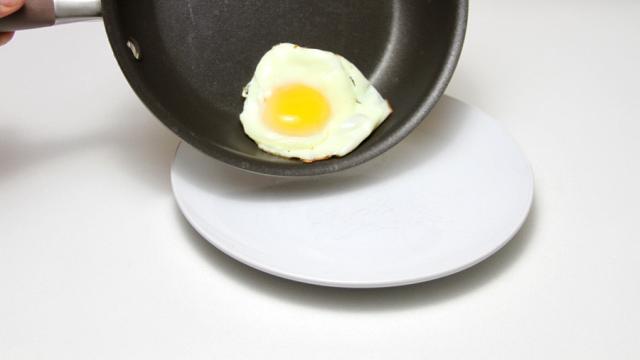In general, I don’t use nonstick cookware, but there are some instances — such as cooking the perfect over-easy egg, omelettes and thin pancakes — where nothing else will do. I do not, however, recommend spending a ton of money on one.
Photo by Your Best Digs.
[referenced url=”https://www.lifehacker.com.au/2017/09/how-to-get-over-your-meat-cooking-concerns/” thumb=”https://i.kinja-img.com/gawker-media/image/upload/t_ku-large/ynz9drsvmemrpfpx5arv.jpg” title=”How To Get Over Your Meat-Cooking Concerns” excerpt=”Meat is not for everyone. If you didn’t grow up in a meat-eating household, or if you’re a former vegetarian, cooking it can seem a little daunting. It is, however, not that hard to cook, but there are some common concerns people have when they first embark down the path of cooking animals.”]
Now, before we go further, let’s address everyone’s favourite nonstick bugaboo: Teflon, and the safety concerns surrounding it. According to the American Cancer Society, you can get flu-like symptoms from breathing in fumes off-gassed by over-heated Teflon (which shouldn’t be heated over 260C), so don’t do that. Other than that, there is some minor concern over PFOA, which is used during the manufacturing of Teflon, but is not present in the final product (or is only present in very small amounts).
Teflon will degrade over time though, and you should toss it when it does. This is less because of potential health dangers and more because, once your Teflon starts failing, your food will start sticking, and what’s the point of having a sticky nonstick pan? There are some Teflon-free, ceramic options out there — and I have one — but I’ve found that those lose their non-stick magic faster than Teflon, and they tend to be more expensive. Yes, cast iron is a nonstick option of sorts, but even the most expertly seasoned pan isn’t going to be as slippery as Teflon. It’s just science. (If you can make it work though, more power to you.)
[referenced url=”https://www.lifehacker.com.au/2016/12/why-nothing-sticks-to-teflon-pans-and-cookware/” thumb=”https://img.youtube.com/vi/uXaP43Zbz7U/0.jpg” title=”Why Nothing Sticks To Teflon Pans And Cookware” excerpt=”If you own non-stick cookware, it’s probably coated with Teflon, which, as you probably know already, is the material that makes it hard for food to stick. What you might not know is why it works so well.”]
As such, I’m a big advocate of buying a cheap, Teflon-coated non-stick pan, using until it starts to grab onto food, then tossing it and getting a new one. Since it’s inevitable that the coating is going to break down, and that it’s also very likely someone in your house will use a metal spatula on it at some point, it just doesn’t make sense to spend the big bucks. (Serious Eats agrees with me on this.)
You can find one for cheap at a restaurant supply store but, if you have an induction burner situation, you’re going to need one made with stainless steel, as aluminium doesn’t work with induction burners. But for everyone else, aluminium is fine, provided it isn’t too thin.

Comments
4 responses to “You Need A Nonstick Pan, But It Doesn’t Need To Be Expensive”
I can’t help but feel guilty for buying a cheap non-stick pan and throwing it out only 6 months after heavy use. Aren’t there better ways to dispose of them other than throwing it in the trash?
Exactly! So bad for the environment. How long does it take for a pan to breakdown.
Poor advice. Many Stainless Steels will not work with induction cooktops. If a magnet won’t stick to it, it’s not going to work.
So how long does a Teflon pan usually last?